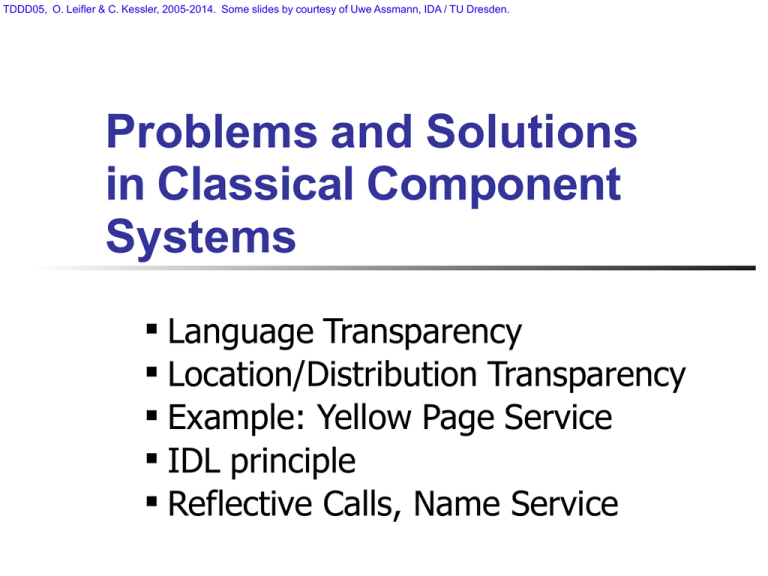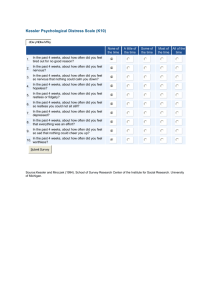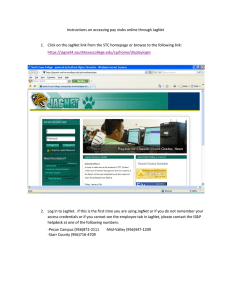Document 13124232
advertisement

TDDD05, O. Leifler & C. Kessler, 2005-2014. Some slides by courtesy of Uwe Assmann, IDA / TU Dresden.
Problems and Solutions
in Classical Component
Systems
Language Transparency
Location/Distribution Transparency
Example: Yellow Page Service
IDL principle
Reflective Calls, Name Service
TDDD05. O. Leifler & C. Kessler, 2005-2014. Some slides by courtesy of Uwe Assmann, IDA / Dresden.
Remember: Justification for COTS
Component definition revisited:
Program units for composition with
A meaningful unit of reuse
2
standardized basic communication
standardized contracts
independent development and deployment
Large program unit
Dedicated to the solution of a problem
Standardized in a likewise standardized domain
Goal: economically stable and scalable software production
TDDD05. O. Leifler & C. Kessler, 2005-2014. Some slides by courtesy of Uwe Assmann, IDA / Dresden.
Obstacles to Overcome …
Technical – Interoperability
3
Standard basic communication
Heterogeneity:
different platforms, different programming languages
Distribution:
applications running on locally different hosts
connected with different networks
TDDD05. O. Leifler & C. Kessler, 2005-2014. Some slides by courtesy of Uwe Assmann, IDA / Dresden.
Technical Motivations
When the Object Management Group (OMG) was formed
in 1989, interoperability was its founders' primary, and
almost their sole, objective:
A vision of software components working smoothly
together, without regard to details of any component's
location, platform, operating system, programming
language, or network hardware and software.
- Jon Siegel
4
TDDD05. O. Leifler & C. Kessler, 2005-2014. Some slides by courtesy of Uwe Assmann, IDA / Dresden.
Interoperability problems
to be solved by component systems
Language transparency:
interoperability of programs
Platform transparency:
interoperability of programs
5
on the same platform, using
different programming languages
written for different platforms using
the same programming language
TDDD05. O. Leifler & C. Kessler, 2005-2014. Some slides by courtesy of Uwe Assmann, IDA / Dresden.
Language Transparency Problems
Calling concept
Calling conventions and calling implementation
Coding, size, little or big endian, …
Layout of composite data
Runtime environment
6
Value and reference objects
Arrays, unions, enumerations, classes, (variant) records, …
Data representation
Call by name, call by value, call by reference, …
Calling implementation: Arguments on stack, in registers, on heap, ...
Data types
Procedure, Co-routine, Messages, …
Memory management, garbage collection, lifetime …
TDDD05. O. Leifler & C. Kessler, 2005-2014. Some slides by courtesy of Uwe Assmann, IDA / Dresden.
Options In General
For n languages:
Direct language mapping:
Adaptation to a general exchange format:
O(n)
Compiling to common type system:
7
O(n2)
Mapping to common language:
1:1 adaptation of pairs of languages:
Standardize a single format (as in .NET): O(1) but very restrictive,
because the languages become very similar
TDDD05. O. Leifler & C. Kessler, 2005-2014. Some slides by courtesy of Uwe Assmann, IDA / Dresden.
Solutions in
Classical Component Systems
Calling concept:
Calling conventions and implementation:
Standard (EJB – Java representation, DCOM – binary standard)
Adaptation to a general exchange format (CORBA GIOP/IIOP)
Runtime environment
8
Existing type system as standard (EJB – Java types)
New standard type system (CORBA IDL-to-Language mapping)
Data representation:
Standardized by the communication library (EJB - Java , DCOM - C)
Implementation for every single language (CORBA)
Data types:
standardized by the communication library (RPC)
Standard by services of the component systems
TDDD05. O. Leifler & C. Kessler, 2005-2014. Some slides by courtesy of Uwe Assmann, IDA / Dresden.
Language Transparency Implementation
Stubs and Skeletons
Language adaptation could take place in Stub or Skeleton (or
both)
9
Stub
Client-side proxy of the component
Takes calls of component clients in language A
and sends them to the
Skeleton
Takes those calls and sends them to the server component
implementation in language B
Adaptation deals with calling concepts, data formats, etc.
Solution of distribution transparency problem postponed ...
TDDD05. O. Leifler & C. Kessler, 2005-2014. Some slides by courtesy of Uwe Assmann, IDA / Dresden.
Stubs and Skeletons
Client
Java
Client
C
Server
Component
C++
Stub
Stub
Skeleton
Call
10
TDDD05. O. Leifler & C. Kessler, 2005-2014. Some slides by courtesy of Uwe Assmann, IDA / Dresden.
Stubs and Skeletons
A typical instance of the proxy pattern
Stub (client-side proxy) delegates calls to Skeleton
Skeleton (server-side proxy) delegates to servant (implementation)
<<interface>>
ServerComponent
+ m ( Data d )
ComponentImpl
+ m ( Data d )
Stub
+m(Data d)
11
Skeleton
TDDD05. O. Leifler & C. Kessler, 2005-2014. Some slides by courtesy of Uwe Assmann, IDA / Dresden.
Distribution
Location transparency / Distribution transparency:
interoperability of programs independently of their execution
location
Problems to solve:
12
Transparent basic communication
Transparently initiate a local/remote call
Transparently transport data locally or remotely via a network
How to handle references transparently?
Distributed systems are heterogeneous
So far, we handled platform-transparent design of components
Usual suspects in distributed systems
Transactions
Synchronization
…
TDDD05. O. Leifler & C. Kessler, 2005-2014. Some slides by courtesy of Uwe Assmann, IDA / Dresden.
Transparent Local/Remote Calls
Communication over proxies (-> proxy pattern)
RPC for remote calls to a handler
13
Proxies redirect call locally or remotely on demand
Proxies always local to the caller
Handler always local to the callee
Déjà vu! We reuse Stubs and Skeletons
TDDD05. O. Leifler & C. Kessler, 2005-2014. Some slides by courtesy of Uwe Assmann, IDA / Dresden.
Remote Stubs and Skeletons
Site 1
Site 2
Remote
Client
Local
Client
Server component
C++
Stub
Stub
Skeleton
Local Call
Remote Call
14
TDDD05. O. Leifler & C. Kessler, 2005-2014. Some slides by courtesy of Uwe Assmann, IDA / Dresden.
Stubs and Skeletons for Distribution
A variant of the Proxy pattern,
using remote procedure call (RPC) when forwarding requests
<<interface>>
ServerComponent
+m(Data d)
ComponentImpl
+m(Data d)
Stub
+ m ( Data d )
15
RPC
Skeleton
TDDD05. O. Leifler & C. Kessler, 2005-2014. Some slides by courtesy of Uwe Assmann, IDA / Dresden.
Stubs and Skeletons
Site 1
Client
Site 2
Stub
RPC
16
Skeleton
Component
Impl
TDDD05. O. Leifler & C. Kessler, 2005-2014. Some slides by courtesy of Uwe Assmann, IDA / Dresden.
Stubs and Skeletons so far …
(same platform)
Stub
17
Skeleton
Language 1
Language 2
1. Map call data to an
exchange format
2. Call Skeleton
3. Receive Call from Stub
4. Retrieve data from the
exchange format
TDDD05. O. Leifler & C. Kessler, 2005-2014. Some slides by courtesy of Uwe Assmann, IDA / Dresden.
… and now
Stub
message
(bytes)
Language 1
Site 1
1. Map data / call
to a byte stream
exchange format
2. Send message,
e.g. via TCP/IP network socket
18
Skeleton
Language 2
Site 2
3. Receive message
from network socket
4. Retrieving data / call
from the byte stream
exchange format
TDDD05. O. Leifler & C. Kessler, 2005-2014. Some slides by courtesy of Uwe Assmann, IDA / Dresden.
Stubs, Skeletons, and Adapters
Site 1
Client
Client
Stub
Stub
Site 2
Adapter
Adapter
Skeleton
CompImpl
Many stubs and skeletons may need to share the same communication infrastructure
(e.g., TCP/IP ports)
Stub and skeleton objects must be created and referenced by need.
Put this support functionality in a separate Adapter layer (“run-time system for RPC”)
19
Remark: In CORBA, this ”Adapter” functionality will be split between the
ORB (communication) and the so-called Object-Adapter (multiplexing).
TDDD05. O. Leifler & C. Kessler, 2005-2014. Some slides by courtesy of Uwe Assmann, IDA / Dresden.
Reference Problem
Target of calls
Call-by-reference parameters, references as results
Reference data in composite parameters and results
Scope of references
20
Thread/process
Computer
Agreed between communication partners
Net wide
How to handle references transparently?
TDDD05. O. Leifler & C. Kessler, 2005-2014. Some slides by courtesy of Uwe Assmann, IDA / Dresden.
Approach
World-wide unique addresses
Mapping tables for local references
Logical-to-physical
Consistent change of local references possible
(In principle) one adapter per computer manages references
21
E.g. computer address + local address
URL, URI (uniform resource identifiers)
1:n relation adapter to skeletons
1:m relation skeletons to component objects
Lifecycle and garbage collection management
Identification (“Who is this guy …?”)
Authorization (“Is he allowed to do this …?”)
TDDD05. O. Leifler & C. Kessler, 2005-2014. Some slides by courtesy of Uwe Assmann, IDA / Dresden.
Change of Local References
Why are you interested in a reference?
Need a reference to computation service (function)
Need a reference to store/retrieve data service
Use a data base
Adapter creates or hands out an arbitrary object instance
wrapping the accesses to the data base
Need a reference to stated transaction to leave and resume
22
Sufficient to have a reference to the component
Adapter creates or hands out reference to an arbitrary object on demand
Adapter must keep correct the mapping logical-to-physical address
Problems with use of self reference inside and outside service
TDDD05. O. Leifler & C. Kessler, 2005-2014. Some slides by courtesy of Uwe Assmann, IDA / Dresden.
Example: Yellow-Page Service
Yellow Pages service
Lookup of a name (database access with caching by YP object)
Internally: 2 types of requests (in adapter/stub/skeleton
layers)
Lookup Request: given
Service type (Yellow pages, phone book, ...)
Address: specifies the YP service object (i.e., a reference)
Requested method (lookup, ...)
and array of parameter objects, e.g. name (string) to look up
Creation Request: Creation of a new YP service object on server
Service type
Address = -1 (denotes creation request)
YP service objects registered in YP skeleton in a hashtable of YP objects
23
TDDD05. O. Leifler & C. Kessler, 2005-2014. Some slides by courtesy of Uwe Assmann, IDA / Dresden.
Example: Yellow Page Service (1)
Service component
Site 1
Client
Stub
Stub
Site 2
Adapter
Adapter
Provides the service implementation
24
Skeleton
CompImpl
TDDD05. O. Leifler & C. Kessler, 2005-2014. Some slides by courtesy of Uwe Assmann, IDA / Dresden.
Example: Yellow Page Service (1)
Service component
25
class YellowPages extends YellowPagesInterface {
private Hashtable cache = new Hashtable ();
//JDBC data base connection:
private static DataBase db = … ;
public String lookup(String name) {
String res;
if ((res = cache.lookup(name)) != null)
return (String)res;
if ((res = db.lookup(name)) != null){
cache.put(name,res);
return (String)res;
}
return “Sorry”;
}
}
TDDD05. O. Leifler & C. Kessler, 2005-2014. Some slides by courtesy of Uwe Assmann, IDA / Dresden.
Example: Yellow Page Service (2)
Client
Site 1
Client
Client
Stub
Stub
Site 2
Adapter
Adapter
Wants to transparently use the service
26
Skeleton
CompImpl
TDDD05. O. Leifler & C. Kessler, 2005-2014. Some slides by courtesy of Uwe Assmann, IDA / Dresden.
Example: Yellow Page Service (2)
Client
class Client {
…
YellowPageInterface yps = YellowPageInterface.getOne();
…
String res = (String)yps.lookup( ...string
…
}
27
to lookup... );
TDDD05. O. Leifler & C. Kessler, 2005-2014. Some slides by courtesy of Uwe Assmann, IDA / Dresden.
Example: Yellow Page Service (3)
Stub (client site)
Site 1
Client
Stub
Stub
Site 2
Adapter
Adapter
Skeleton
1:1 mapping to service component
Manages services objects of that component on client site
Is called from the client
28
CompImpl
TDDD05. O. Leifler & C. Kessler, 2005-2014. Some slides by courtesy of Uwe Assmann, IDA / Dresden.
Example: Yellow Page Service (3)
Client Stub
class YellowPageStub extends YellowPageInterface {
private ClientAdapter ca = new ClientAdapter();
private static Hashtable yellowPageObjects = new Hashtable();
public String lookup(String name) {
ca.invoke( “Yellow Pages”, yellowPageObjects.get(this),
“lookup”, Object[]{name});
return (String)ca.res;
}
// client-side constructor:
public YellowPageInterface getOne() {
ca.invoke(“Yellow Pages”, Integer(-1), “new”, null);
yp = new YellowPageStub();
yellowPageObjects.put( yp, ca.res );
return yp;
}
29
}
TDDD05. O. Leifler & C. Kessler, 2005-2014. Some slides by courtesy of Uwe Assmann, IDA / Dresden.
Example: Yellow Page Service (4)
Client Site Adapter
Site 1
Client
Stub
Stub
Site 2
Adapter
Adapter
Skeleton
Manages the basic communication on client site
Is called from the client stubs
30
CompImpl
TDDD05. O. Leifler & C. Kessler, 2005-2014. Some slides by courtesy of Uwe Assmann, IDA / Dresden.
Example: Yellow Page Service (4)
Client Adapter
31
class ClientAdapter {
Socket s = new Socket( serverHost , serverPort ); //magic
public Object res;
public void invoke( String service; Integer addr; String method; Object[] args) {
ObjectOutputStream os = new ObjectOutputStream(s.getOutputStream());
ObjectInputStream is = new ObjectInputStream(s.getInputStream());
os.writeObject(service);
os.writeObject(addr);
os.writeObject(method);
if ( addr==Integer(-1) && method.equals(“new”) ) {
os.flush();
res = is.readObject(); }
else {
os.writeObject(args);
os.flush();
res = is.readObject();}
s.close(); }
}
}
TDDD05. O. Leifler & C. Kessler, 2005-2014. Some slides by courtesy of Uwe Assmann, IDA / Dresden.
Example: Yellow-Page Service (5)
Server-side Adapter
Site 1
Client
Stub
Stub
Site 2
Adapter
Adapter
Skeleton
Manages the basic communication on server site
Calls the service skeletons
32
CompImpl
TDDD05. O. Leifler & C. Kessler, 2005-2014. Some slides by courtesy of Uwe Assmann, IDA / Dresden.
Example: Yellow Page Service (5)
Server-side Adapter
class ServiceAdapter extends Thread {
ServerSocket ss = new ServerSocket( 0 ); //magic
public void run() {
while( true ) {
try { Socket s = ss.accept();
ObjectInputStream is =
new ObjectInputStream(s.getInputStream());
ObjectOutputStream os =
new ObjectOutputStream(s.ObjectOutputStream());
String service =(String) is.readObject();
if (service.equals(“Yellow Pages”)
new YellowPagesSkeleton(os,is).start();
else if (service.equals(“Phone Book”)
new PhoneBookSkeleton(os,is).start();
else if …
else System.err.println(“Unknown service.”);
} catch( ... ) {…}
}
}
}
33
TDDD05. O. Leifler & C. Kessler, 2005-2014. Some slides by courtesy of Uwe Assmann, IDA / Dresden.
Example: Yellow Page Service (6)
Skeleton
Site 1
Client
Stub
Stub
Site 2
Adapter
Adapter
Skeleton
1:1 mapping to service component
Manages service objects of that component on server site
34
CompImpl
TDDD05. O. Leifler & C. Kessler, 2005-2014. Some slides by courtesy of Uwe Assmann, IDA / Dresden.
Example: Yellow Page Service (6)
Skeleton
35
class YellowPagesSkeleton extends Thread implements Skeleton {
static Hashtable yellowPageObjects = new Hashtable();
YellowPagesSkeleton( ObjectOutputStream os, ObjectInputStream is ) { … }
public void run() { …
Integer addr = (Integer) is.readObject();
if (addr == Integer(-1)) { // creation of the service:
Integer address = new Integer( yellowPageObjects.size() ) ;
yellowPageObjects.put( address, new YellowPage() );
os.writeObject( address );}
else { // service query:
YellowPage yp = (YellowPage) yellowPageObjects.get( addr );
String method = (String) is.readObject();
if (method.equals(“lookup”) {
String name = (String) is.readObject();
String res = yp.lookup( name ); // finally: the call to the service
os.writeObject(res); }
else if (method.equals(“store”) { … }
else System.err.println(“Unknown service method.”); }
os.flush(); s.close();
}}
TDDD05. O. Leifler & C. Kessler, 2005-2014. Some slides by courtesy of Uwe Assmann, IDA / Dresden.
Sequence Diagram, Creation
Client
Stub
getOne
Adapter
Client
Side
Adapter
Server
Side
Skeleton
Service
CompImpl
invoke
Socket
(“getOne”) Communication
Call object
start()
new
return
Stub
Object
36
res
handle
Socket
Communication
handle
return
Service
CompImpl
TDDD05. O. Leifler & C. Kessler, 2005-2014. Some slides by courtesy of Uwe Assmann, IDA / Dresden.
Sequence Diagram, Call
Client
Stub
lookup
Adapter
Client
Side
Adapter
Server
Side
Skeleton
Service
CompImpl
invoke
(handle,
Socket
“lookup”) Communication
Call object
start()
lookup
return
String
37
res
Object
Socket
communication
return
String
TDDD05. O. Leifler & C. Kessler, 2005-2014. Some slides by courtesy of Uwe Assmann, IDA / Dresden.
Technical remark
Note: This was a simplification!
Some issues are solved differently e.g. in CORBA or Java
RMI.
Site 1
Site 2
Client
Client
Stub
Stub
OA
ORB
ORB
OA
Skeleton
CompImpl
”Adapter” functionality is, in CORBA, split up between ORB (communication/runtime system) and Object Adapter.
The communication mechanism, here Java sockets etc., is in CORBA provided by
the ORB (which abstracts from language or platform specific communication
mechanism/API).
The server object registry (static hashtable yellowPageObjects), here in the
Skeleton, which is used to direct a call to the ”right” server object, would in CORBA
reside in the Object Adapter (who is responsible for activating / terminating ”its”
server processes and objects, resolving interoperable object references, and
38
TDDD05. O. Leifler & C. Kessler, 2005-2014. Some slides by courtesy of Uwe Assmann, IDA / Dresden.
Who Realizes Stubs and Skeletons?
Programmer ?
Insight
Stub
Export interface is component dependent
Implementation is source language dependent
Skeleton
Import interface is component dependent
Implementation is target language dependent
Idea
39
Much handcraft, boring and error prone
Generate export and import interfaces of Stub and Skeleton
from a component interface definition
Take a generic language adapter for the implementation
TDDD05. O. Leifler & C. Kessler, 2005-2014. Some slides by courtesy of Uwe Assmann, IDA / Dresden.
Interface Definition Language (IDL)
Language to define the
Programming-language independent type system
General enough to capture all data types in HPL (host progr. lang.)
Procedure of construction
40
Interfaces of components
Data types of parameters and results
Define component with IDL
Generate stubs and skeletons with required languages
using an IDL compiler
Implement the frame (component) in respective language
(if possible reusing some other, predefined components)
TDDD05. O. Leifler & C. Kessler, 2005-2014. Some slides by courtesy of Uwe Assmann, IDA / Dresden.
Automatic Generation of
Stubs and Skeletons
IDL
IDLInterface
Interface
IDLCompiler
generate
Client
Implementation
Client
Stub
Client HPL
Compiler
Client program
41
Server
Skeleton
Server
Implementation
Server HPL
Compiler
Server program
TDDD05. O. Leifler & C. Kessler, 2005-2014. Some slides by courtesy of Uwe Assmann, IDA / Dresden.
IDL Interface Can Be Generated
Specification in IDL and
host language
Determined language
binding,
standardized IDL-tolanguage mapping
Generation of stubs and
skeleton is IDL-compiler
independent
Language-specific IDL
compilers
CORBA
42
Specification in host language
only
Retrieve the IDL spec from
the HPL interface definitions
(see lecture on metaprogr.)
Have only one source of IDL
compilers, guaranteeing
consistency
Quasi standard
Java, DCOM, .NET
TDDD05. O. Leifler & C. Kessler, 2005-2014. Some slides by courtesy of Uwe Assmann, IDA / Dresden.
Required Formal Properties
of the IDL-to-Language mapping
Let PL: IDL TSPL be the mapping from an
interface definition language IDL to the
type system TS of a programming language PL
43
Well-definedness
for all PL : PL: IDL TSPL is well defined
Completeness
for all PL : PL-1: TSPL IDL is well defined
Soundness
for all PL : PL-1 PL: IDL IDL is IDL
for all PL : PLPL-1: TSPL TSPL is PL
TDDD05. O. Leifler & C. Kessler, 2005-2014. Some slides by courtesy of Uwe Assmann, IDA / Dresden.
Example revisited
IDL compiler must generate code for server-side adapter
(example code contained the service dispatcher)
Idea:
44
This is very nasty
One server-side adapter per site –
should be independent of client components provided
Current solution prevents dynamic loading of services
Decoupling of adapter and skeletons
Provide a basic (name) service for identifying the components
(skeletons) of a site
Components register with name and reference
Generic adapter provides this service
TDDD05. O. Leifler & C. Kessler, 2005-2014. Some slides by courtesy of Uwe Assmann, IDA / Dresden.
Name Service
<<interface>>
Component
ComponentImpl
+ m ( Data d )
+ m ( Data d )
Skeleton
NameService
+resolve(Name):Skeleton
+register(Name,Skeleton)
Stub
+ m ( Data d )
45
Adapter
TDDD05. O. Leifler & C. Kessler, 2005-2014. Some slides by courtesy of Uwe Assmann, IDA / Dresden.
Example: Generic Server Adapter
46
class ServiceAdapter extends Thread {
ServerSocket ss = new ServerSocket( 0 );
NameService ns = new NameService();
public void run() {
while( true ) {
try {
Socket s = ss.accept();
ObjectInputStream is = new ObjectInputStream ( s.getInputStream() );
ObjectOutputStream os = new ObjectOutputStream (s.getOutputStream());
String service = (String) is.readObject();
Skeleton sk = null;
if ((sk = ns.resolve(service)) != null) {
sk.init( os, is );
sk.start(); }
else System.err.println(“Unknown service.”);
} catch(...) {…} …
}
}
TDDD05. O. Leifler & C. Kessler, 2005-2014. Some slides by courtesy of Uwe Assmann, IDA / Dresden.
Name Server Generalized
Search for the right site providing a desired component
(extended name service)
Search for a component with known properties, but unknown
name (trader service)
47
Like an extended name service
Components register with name, reference, and properties
Match properties instead of names
Return reference (site and service)
Needs standardized properties (Terminology, Ontology)
Functional properties (domain specific functions …)
Non-functional properties (quality of service …)
TDDD05. O. Leifler & C. Kessler, 2005-2014. Some slides by courtesy of Uwe Assmann, IDA / Dresden.
Summary
Component systems provide location, language and platform
transparency
Is the IDL compiler essential?
48
Stub, Skeleton
One per component
Technique: IDL compiler
Adapters on client and server site
Generic
Technique: Name services
No! Generic stubs and skeletons are possible, too.
Technique: Reflection and dynamic invocation
TDDD05. O. Leifler & C. Kessler, 2005-2014. Some slides by courtesy of Uwe Assmann, IDA / Dresden.
Reflection & Dynamic Invocation
Reflection
Dynamic invocation
Language incompatibilities (solved)
Access to interfaces (open)
Solution: IDL is already the standard
49
to call the components
Problem
to inspect the interface of an unknown component
for automatic / dynamic configuration of server sites
Standardize an IDL run time representation and access
Define an IDL for IDL representation and access
TDDD05. O. Leifler & C. Kessler, 2005-2014. Some slides by courtesy of Uwe Assmann, IDA / Dresden.
Example: Generic Server Skeleton Using
Reflection
class GenericSkeleton extends Thread {
50
static ExtendendHashtable objects = new ExtendedHashtable();
ObjectOutputStream os;
ObjectInputStream is;
…
public void run() { …
Integer addr= (Integer) is.readObject(); //handler
String mn = (String) is.readObject(); //method name
Class[] pt = (Class[]) is.readObject(); //parameter types
Object[] args= (Object[]) is.readObject(); //parameters
Object o = objects.getComponent( addr );
//object reference by reflective call
Method m = o.getClass().getMethod( mn, pt );
//method object by reflection
Object res = m.invoke(o,args); //method call by reflection
os.writeObject(res);
os.flush(); s.close();
TDDD05. O. Leifler & C. Kessler, 2005-2014. Some slides by courtesy of Uwe Assmann, IDA / Dresden.
Services
Predefined functionality standardized
Distinguish
51
Reusable
Basic
Useful (only) with component services
Examples discussed: name and trader service
Further: multithreading, persistency, transaction, synchronization
General (horizontal services)
Useful (per se) in many domains
Examples: Printer and e-mail service
Domain specific (vertical services)
Result of domain analysis
Examples: Business objects (components)
TDDD05. O. Leifler & C. Kessler, 2005-2014. Some slides by courtesy of Uwe Assmann, IDA / Dresden.
Summary: What Classical Component
Systems Provide
Technical support: remote, language and platform
transparency
Economic support: reusable services
52
Stub, Skeleton
One per component (technique: IDL compiler)
Generic (technique: reflection and dynamic invocation)
Adapters on client and server site
Generic (technique: Name services)
Basic: name, trader, persistency, transaction, synchronization
General: print, e-mail, …
Domain specific: business objects, …



